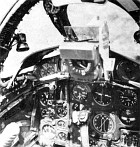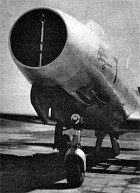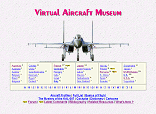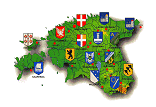Aircraft Profile #143. Dassault MD.450 Ouragan |
|
|
In March 1945 Marcel Bloch, as he then was, returned to France, a survivor of the infamous Buchenwald concentration camp. He re-entered the aviation industry early in 1946, adopting for himself and his new company the nom de guerre "Dassault" by which he had been known in the Resistance. Little over a year later, with his plant and his equipment barely re-established, he embarked - on his own initiative - on the design of the first all-French jet aeroplane, and within 15 more months had built and flown it. Dassault, firmly convinced that the French industry could, and should, produce its own jet fighter, set down his ideas for such a design during 1947. They were based on American rather than British lines, following a basic configuration like the Republic F-84 and using a very thin wing after the fashion of the Lockheed F-80. The new interceptor laid particular emphasis on a fast rate of climb, and was also capable of a secondary ground attack role with rocket projectiles. It was to be powered by the Rolls-Royce Nene centrifugal turbojet, already being licence-built in France by Hispano Suiza for the SNCASE Mistral. Talks with the Bureau d'Etudes et Plans d'Etat-Major in September
As first flown, the M.D.450-01 was unarmed, had an unpressurised cabin, and was minus the wingtip fuel tanks that later became a standard feature: the powerplant was a 2260kg Hispano Suiza Nene 102. The basic layout of the Ouragan (Hurricane) was essentially straightforward, with a single divided duct in the nose carrying the intake flow
The M.D.450-02, completed at Boulogne, was flown for the first time in May 1949. This had more internal equipment and a pressurised cockpit. Completion of the third aircraft was delayed in order to embody changes suggested by experience with the first two, the -03 eventually making its first flight on 2nd June 1950, powered by the Nene 104B engine envisaged for the production aircraft. A diary of the prototype programme follows: M.D.450-01: Delivered to the Centre d'Essais en Vol, Bretigny-sur-Orge, for service trials in April 1949. By July had attained level speed of 980km/h and climb to 9,000m in 6 min. 21 sec. Climb to 12,000m in
M.D.450-02: To CEV Marignane November 1949 for manoeuvrability trials; altitudes up to 15,000m attained. Damaged on landing 01.02.50 (pilot Monier) following malfunction of nose wheel doors. M.D.450-03: Cannon and R.P. trials at CEV Cazaux from July 1950, initially with four 15mm guns, later with four 20mm. In July 1949, Avions Marcel Dassault received an order for 15 pre-series Ouragans for various aspects of the test programme. This order was subsequently reduced to 12 aircraft, details of which are as follows: M.D.450-1: First flight 30.11.50, delivered to CEV Bretigny 9.2.51 and to Cazaux later the same day. M.D.450-2: To Bretigny 15.2.51. (In later years this aircraft was transferred by rail and displayed, minus landing gear, outside Chambery air base) M.D.450-3: To Bretigny 23.2.51. Development aircraft for Hispano Suiza HS403 afterburner for the Nene engine, increasing thrust to approx. 3100kg. First flight with afterburner late 1953. M.D.450-4: Believed used for static airframe testing. M.D.450-5: First flight 28.4.51, to
M.D.450-6: First aircraft equipped with electrically-operated trim tabs in the elevator and rudder. M.D.450-7: First flight 04.08.51. to Bretigny 03.10.51. M.D.450-8: First flight 12.09.51. Also known as M.D.450R (reconnaissance), was equipped with only two 20mm cannon, remaining space being occupied by a camera pack. Underwing drop-tanks as well as standard wingtip tanks. M.D.450-9: First flight 16.11.51. Evaluation of performance with underwing ordnance, including R.Ps., napalm, or two 200kg, 225kg or 450kg bombs. M.D.450-10: First flight 05.12.51. Believed to be the first of two testbeds for SNECMA Atar 101B axial turbojet; first flight with Atar, 02.02.52. Nose serial appeared as "01", fin distinguished by "A" (for Atar) above the tailplane, and "V" on rear fuselage aft of the roundel. M.D.450-11: First flight 21.01.52. Also known as M.D.450-30L, signifying twin 30mm DEFA cannon in place of the standard armament, and lateral engine air intakes. Built as single-seat development aircraft, with standard Nene engine, for the projected Tay-engined M.D.451 Aladin two-seat night fighter. (The Aladin project was successively re-designated M.D.453 Harmattan, then Mystere III,
M.D.450-12: First flight 10.05.52. Probably the second Atar testbed, distinguished by "02" on nose and "A" on fin. At the time of the pre-series order, the French government was debating a five-year plan for rebuilding the French air forces which envisaged no fewer than 850 Ouragans, together with 300 Vampires, for the interception and ground attack role. But the initial Armee de I'Air contract, when announced on 31st August 1950, was fixed at 150 aircraft, and it was to be another three years before the first foreign order materialised. Nevertheless, the home order still represented a substantial contract, which was followed by three further orders each for 100 aircraft (though the final one was cancelled in January 1952 in favour of the Mystere IIC). The Dassault plant could not accomplish this unaided: not entirely from a lack of facilities, but because the speed of the Ouragan's development had left little time for such refinements as full "productionisation" of the design. Hence the completion of front fuselages was delegated to SNCASE at Toulouse, who eventually built 350 units; while the SNCASO factories at Saint-Nazaire and Bouguenais completed 365
The first production Ouragan, numbered 101, was flown for the first time on 5th December 1951. By the end of 1952, 39 production Ouragans had been completed; a further 193 were built in 1953, and the remaining 118 by midsummer 1954. The only major modification required was to the doors enclosing the nose wheel landing leg. Originally in four sections, these had, in addition to causing accidents to the first two prototypes, proved susceptible to damage when the guns were fired, and were replaced on the 51st and subsequent machines by a larger, two-piece door. The cockpit was equipped with a Martin-Baker ejection seat on the prototypes, pre-series and the first dozen or so production aircraft, but thereafter with the SNCASO Type E.86 seat. THE OURAGAN IN SERVICE When it began to replace the Vampire in squadron service in 1952, the Ouragan's full service test programme had not been completed. As a result, service pilots found themselves performing a few involuntary manoeuvres when they put the fighter through its
Ouragans of the Armee de l'Air equipped two French fighter groups (Escadres de Chasse) of the 1er Commandement Aerienne Tactique as a component of NATO's 4th Allied Tactical Air Force: the 2e Escadre at Base Aerienne 102, Dijon, and the 4e Escadre at Bremgarten; and one group of the Defense Aerienne du Territoire, the 12e Escadre at B.A.103, Cambrai. Each Escadre consisted of three Escadrons (wings), and each wing of two Escadrilles (squadrons). An Escadron normally comprised 25 aircraft plus two reserves. The Ouragans' front-line service life was comparatively short - they began to be replaced by the
THE "BAROUGAN" This was the nickname given to a small number of Ouragans fitted with an experimental "diabolo" undercarriage and a tail braking parachute. The name was a fusion of Ouragan with baroud, an Arab word meaning battle, and signified the intention of adapting the Ouragan for use from unprepared airstrips in Algeria. Each leg of the main landing gear was fitted with a twin-wheel unit with low-pressure tyres, retracting into a ventral fairing. The first Ouragan modified was No. 140, first flown with the new, Messier-designed gear at Melun-Villaroche on 24th February 1954. It made its first take-off from grass on 22nd March, and its first grass landing three days later. Successful landings were subsequently accomplished in distances from 250-350 metres and take-offs from 570-770 metres, at varying all-up weights, before the aircraft was delivered to Bretigny on 5th May for continued evaluation. On 23rd October
OURAGANS IN THE MIDDLE EAST Never, since its creation on 14th May 1948, has Israel enjoyed peace with its Arab neighbours. Despite uneasy truces in 1948 with all except Iraq (with whom it is still technically at war), Israel has been under constant pressure of one kind or another, especially from Egypt. By mid-1955 the Egyptian government was openly admitting, indeed proclaiming, its "heroic" fedayeen (commando) raids against civilian targets across the Israeli border; and when, in October 1955, Egypt concluded an arms deal with Czechoslovakia for the supply of Russian-designed military equipment, the Israeli government was obliged to re-equip its own forces with more modern weapons. To augment the small force of assorted Meteors, which were then the IDF/AF's only jet aircraft, orders were placed for 24 Mystere IIC fighters and a similar number of CL-13B Sabre 6's. The Canadian government, however,
This was provided by the acquisition of sufficient Ouragans to equip five close support squadrons. Twenty-four were delivered direct from AMD at Merignac, and at least 42 ex-Armee de l'Air machines were supplied to Israel. The final total received by the IDF/AF has never been confirmed officially, but is believed to be at least 75. The first Ouragans flown out to Israel bore radio call signs (commencing 4.X.FRA) for the journey, and on arrival were allocated IDF/AF serial numbers commencing at 5641: subsequently the first two digits were dropped, the aircraft displaying two-figure serials only, although more recently three-figure serials have been applied. Delivery was completed during 1955. In April 1956 a sustained fedayeen campaign was mounted by the Egyptians, and an IDF/AF Ouragan crew drew its first blood on 12th April, when an Egyptian Vampire was shot down over Israeli territory. It was, however, during the Sinai campaign that the Ouragan gave proof of its operational worth. On 21st October a pro-Egyptian government was returned in Jordan; within three days both
When the campaign opened on 29th October with airborne landings in In the first encounter, two IDF/AF Ouragans, hunting an armoured column east of Bir Hama, were attacked by eight MiG-15's, with four more MiG's giving top cover. One Ouragan was hit by two 37mm shells before the Egyptian aircraft were beaten off (and one shot down) by two Israeli Mysteres, and the other was obliged to force-land after running out of fuel. Both aircraft were salvaged and back in operation the following day. The other engagement, which was more successful for the Ouragans, involved another pair which had taken off at noon, armed with napalm, to
"What the MiG ought to have done was to make a pass and gain height and try again. But instead, he came into a turn with my Number Two. His radius of turn was much bigger than the Ouragan's, and when I followed him in his turn, I started to close. My Number Two couldn't release his wing-tanks, but in spite of this the MiG couldn't close the turn. "I saw the MiG shooting in the turn and of course missing because of the very high angle-off (deflection) and because of the high "G". I made the same mistake myself - I fired one short burst in the turn and missed. I knew of course that there was another MiG somewhere above, but I couldn't see it. I was anxious about it. Anyway, I could see that the first MiG was closing the turn on my Number Two, and if he changed the bank
"This change of direction brought me into a favourable position to fire on the first MiG, and I gave him a long burst and saw pieces fall off him. He immediately pulled up and straightened his wings. I shot at him again, hit him again and saw a big hole in his left wing and something burning and a lot of white smoke. I shot again but only one cannon fired, but it hit him near his jet pipe. Because my cannons were not working any more, I then came home". Two other Ouragans were involved earlier on 31st October in the capture of the Ibrahim-el-Awal, the former British "Hunt" class destroyer H.M.S. Cottesmore. The target was pin-pointed by an IDF/AF C-47, after which the two Ouragans, each with a full battery of rocket projectiles, moved into the attack. In the words of one of the pilots: "The weather was cloudy and we were flying at 1500m. The wake of the ship showed that she had been turning from west to due east, but at the time of our attack she was on
"I dived and released all sixteen rockets, at about 500m from a height of 200m. I broke from the ship before I could see the hits, but I saw pieces of metal in the air. I broke high and to the left and saw my Number Two leaving the ship after releasing his rockets. After this attack by my Number Two, the ship was hidden in smoke. There were two kinds of smoke, some black and some very white". Its manoeuvrability at low level and stability as a firing platform made the Ouragan even more valuable for ground attack than in air-to-air combat, and the squadrons flying it accounted for a major proportion of the tanks and other military vehicles destroyed from the air. Only two Ouragans were lost during the five days' fighting, both to enemy small-arms fire, which was far more lethal than either the Egyptian fighters or anti-aircraft defences. As the IDF/AF commander-in-chief summed up later, "The Ouragan was a much better aeroplane than had been thought". Since Sinai, the Ouragan has continued to give
OURAGANS IN INDIA On 25th June 1953 the Indian government ordered 71 Ouragans, basically similar to the standard production model but powered by 2350kg Nene 105A engines. The first four aircraft, bearing serials IC553 to IC556, were flown to India from Istres by IAF pilots on 17th October 1953, arriving in Delhi eight days later; a further 35 left Toulon for Bombay on 30th October aboard the carrier Dixmude, and the remainder early in 1954. Subsequent orders for 20 and 13 Ouragans brought the overall total to 104. In service with Operational Command of the IAF, the Ouragan was given the Hindi equivalent of its French name - Toofani. Official IAF sources decline to say whether the Toofani has seen any combat service; but in view of the prevalence in IAF squadrons of the superior Mystere IVA (which began to replace it in 1957), and more recently the Gnat (now in large-scale production in India), this would seem unlikely - an opinion borne out by the Pakistan Air Force, who have no record of encountering it in the Kashmir or any other operations. Kenneth Munson, 1967 |
 All the World's Rotorcraft
|

















